7 Most Popular Liposuction Alternatives That Work
Summary:
- Liposuction is still the most effective procedure when it comes to localized fat deposits
- Patients who cannot or do not want to undergo a surgery can explore non-invasive options
- Some of the technologies do work in specific cases
Even 50 years after the procedure had gone mainstream among plastic surgeons and patients, liposuction is still one of the most misunderstood plastic surgery services out there.
Many people still believe that liposuction is a weight loss tool. It’s not.
Some people believe that liposuction is the be-all and end-all procedure that will give them the celebrity looks overnight. Unfortunately, it can’t.
What it can do—and does exceptionally well—is remove fat from stubborn fat pockets that do not respond to diet and exercise efforts.
In general, liposuction is especially effective for patients with:
- Good, elastic skin. Since liposuction does not involve removing excess skin, it is imperative that the skin is elastic to achieve a desired look. Otherwise, once the fat is removed, there may be some “hanging skin” left, which is neither healthy nor aesthetically pleasing.
- Localized pockets of ‘stubborn fat’. Being a prime body-sculpting tool, liposuction can tackle localized fat pockets with dramatic efficiency. These include waist (“love handles“), neck area (“double chin“), thighs (“no thigh gap“), back and abdomen area (“folds of fat.”)
- Good general health. While this is true for all surgical procedures, it is especially important to mention that in this article. People with a history of medical conditions or weak overall health usually prefer smaller-scope liposuction alternatives.
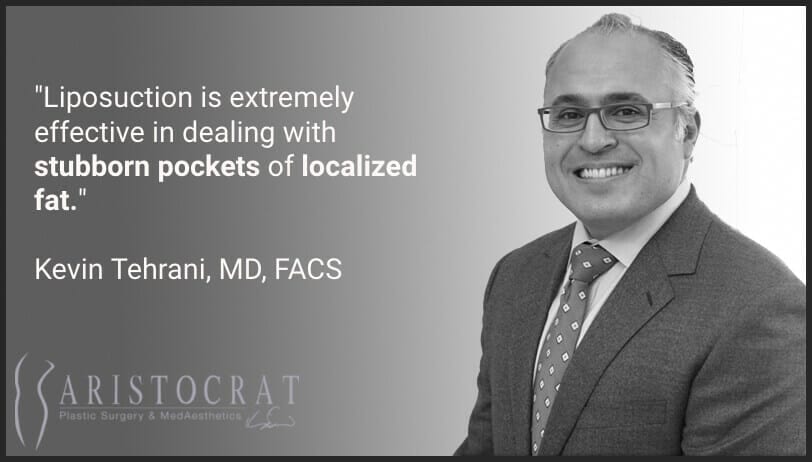
At the same time, liposuction is not a good option for some patients:
-
- Weight loss. Liposuction is a body-contouring tool, not a weight loss procedure. While a few pounds of fat will be removed from your body, it would be incorrect to consider liposuction if your primary goal is to lose weight. Liposuction should be considered only after all efforts are made to lose weight naturally. It’s about removing inches, not pounds. At Aristocrat, we also offer a diet plan—called the Nuvo diet—which helped our very own Dr. Kevin Tehrani lose 40 pounds.
- Cellulite. One of the bigger misconceptions we hear often is that liposuction can “treat” the appearance we call “cellulite.” While lipo can definitely help with that, the large part of the problem is the appearance of the skin, not the fat itself. Read on to learn about other options that can help you achieve the desired look in the buttocks and hips area.
- Flat belly. As you’ll learn in just a minute, tummy tuck is the most optimal procedure for men and women seeking a more pronounced, flatter look in the abdomen area. Liposuction does not deal with excess skin and globally distributed fat, which makes it a sub-optimal choice for men and women looking to change what their belly looks like.
I Think Liposuction Is Right For Me. Why Would I Consider Alternatives?
It is important to understand that there are always trade-offs when going under the knife:
-
-
- Liposuction is extremely effective, but will require some recovery down-time
- Liposuction is very safe, but, as any surgical procedure, there are risks involved
- Liposuction is minimally invasive, but it does leave small, temporary scars
-
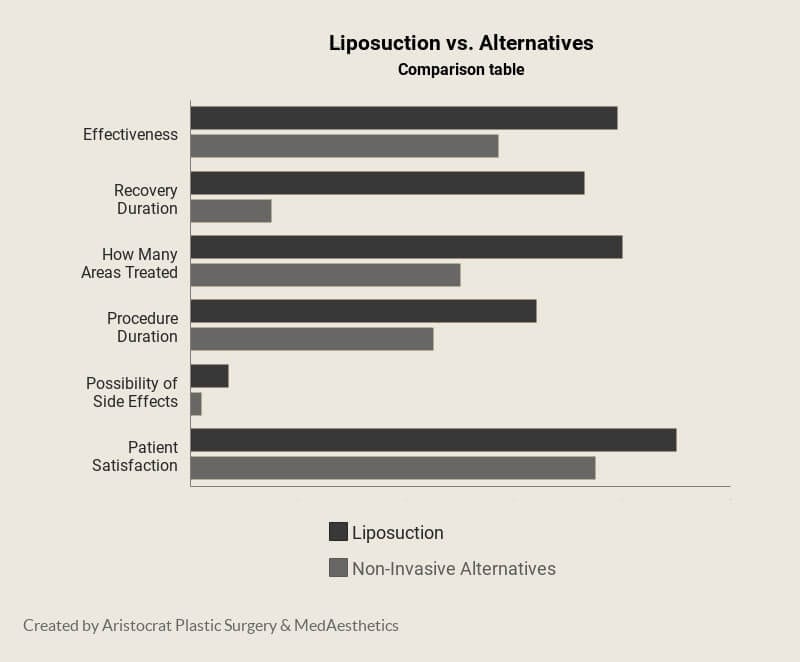
That being said, it is in your best interests to explore all of your options before committing to liposuction.
The biggest downside of all minimally invasive and non-invasive liposuction alternatives is their effectiveness.
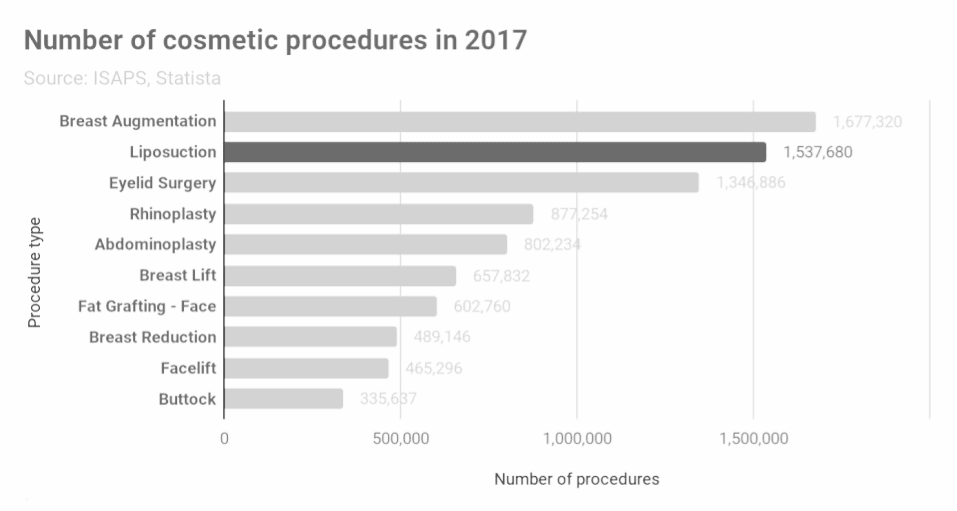
Even with all the sophisticated fat-reducing technology available today, it is very difficult—if not impossible—to achieve a comparable level of results in a fixed time frame.
Liposuction alternatives usually take numerous visits and a longer time period before they start showing significant results.
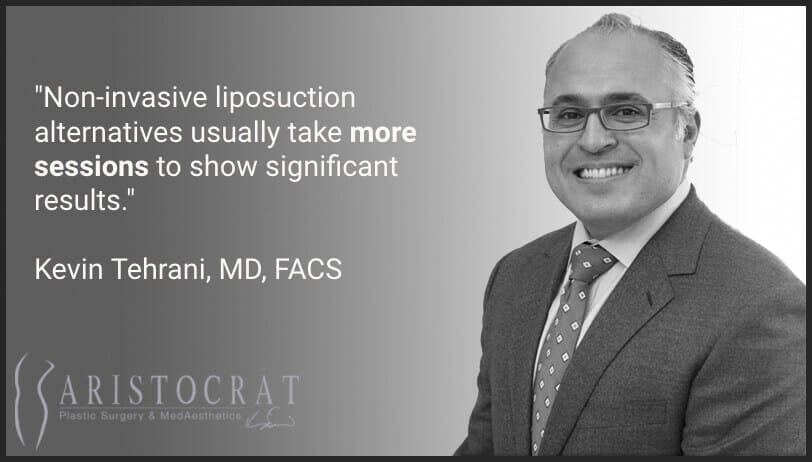
However, there are certain cases where alternative liposuction devices can work and create a lasting impact.
Often times, we use non-invasive liposuction alternatives not as alternatives per se, but as supplementary devices that improve the overall results.
Their usefulness varies significantly on an individual basis. Read on to learn which of these technologies can be used to target specific fat problems.
First Things First: What Is Liposuction, Exactly?
To make sure we’re on the same page before comparing the alternatives, let’s quickly go over a few key points about the main hero of this story.
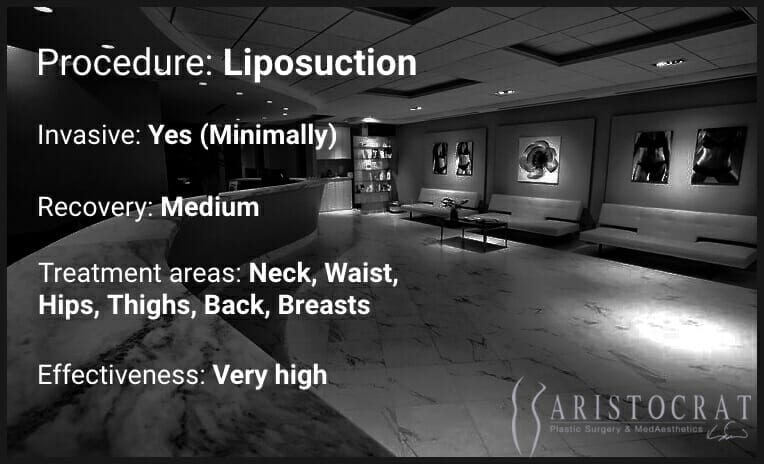
Liposuction is a minimally invasive procedure, during which small incisions are made in target treatment areas.
Then, a small, narrow tube (called cannula) is inserted through the incision.
As it reaches the very core of the localized fat pocket, the doctor will apply gentle movement of the cannula, distorting fat deposits.
Once the fat cells are broken down, they are suctioned out of your body through a vacuum pump or syringe.
Targeting fat pockets this way is really good for a few reasons.
First of all, since only deep fat is being removed, there is only a very small chance of skin injury—a common problem with other “minimally invasive”
techniques.
For the same reason, it allows you to treat the very core of the problem, and not just the surface layer of fat.
Lastly, it allows for really impressive results, even after the first session. That is rarely something the alternatives can boast of.
To date, liposuction is the single best solution for the right candidates in terms of effectiveness and safety.
The Big Question: Liposuction vs. Tummy Tuck
Many patients have the misconception that tummy tuck and liposuction are alternatives. They’re not. They’re completely different procedures, which always go hand in hand as an effective combination.
The most important thing to understand is that tummy tuck removes excess skin along with some belly fat, while liposuction only removes fat.
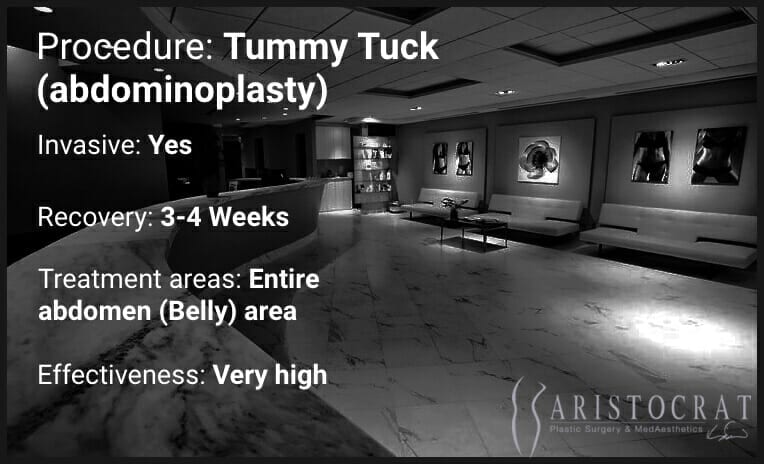
It does not mean that tummy tuck is a better procedure per se. They’re just two different procedures aimed at different people with individual expectations.
Here are a few key points on how they’re different:
- Liposuction is minimally invasive, while tummy tuck will require a bigger surgery
- Liposuction is a much smaller and quicker surgery than tummy tuck
- Liposuction can target many different problematic body areas (chin, neck, abdomen, flanks (“love handles”), breasts), while tummy tuck addresses only the abdomen area
- Liposuction may not always provide optimal results for patients with saggy skin or bad muscle tone, while tummy tuck offers a bigger makeover
- Liposuction recovery is quicker and easier compared to tummy tuck recovery
- Liposuction leaves barely noticeable, minimal scars, while tummy tuck requires a much larger incision
But that doesn’t answer the main question: which one is best for you? Which one should you get first?
The general answer is this:
- If you want to address a specific “fat pocket” and have good skin laxity and muscle tone, then you might be satisfied with liposuction alone
- If you want to tighten your entire belly area or have bad skin laxity or a lot of excess skin, then you’ll want to explore tummy tuck options (possibly a combination of the two procedures)
Here are a few key differences between ideal liposuction candidates and ideal tummy tuck candidates:
- Liposuction candidates are usually below 40, while tummy tuck patients are often above that age
- Liposuction candidates target specific “unruly” body parts, while tummy tuck candidates want major changes in the belly area
- Liposuction candidates have good skin laxity and muscle tone, while tummy tuck candidates have stretched, inelastic skin in the abdomen area
- Liposuction candidates are more inclined towards a quicker, safer procedure rather that tummy tuck patients who are ready to commit to a larger transformation
Often times, tummy tuck is chosen as part of the “mommy makeover” program to help mothers restore their youthful appearance. This is especially true for mothers who:
- Have had several children
- Carried twins
- Carried large babies
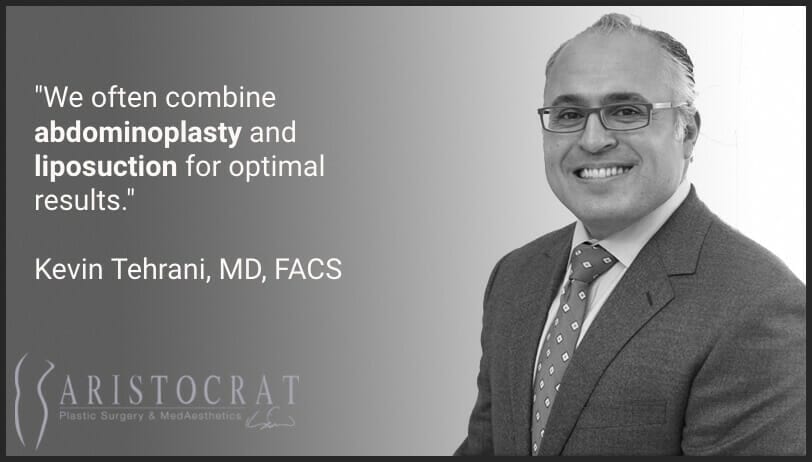
Since these two procedures are often combined, it would be inaccurate to call them alternatives. Each of the procedures offers tremendous benefits to the right patients.
In fact, our patients often opt for a liposuction treatment during or after their tummy tuck. Since it can easily be combined into one session, you might tackle a fat pocket or two while your abdominoplasty procedure is ongoing.
Which Procedure Is More Popular? What Do People Say?
Naturally, we get more inquiries about liposuction—just because it’s a much smaller, quicker and safer procedure. Not everyone needs a full tummy tuck to achieve their desired belly look.
That being said, we are proud to have made hundreds of people happy with the procedure of their choice. After a thorough consultation, we advise people on how they can achieve goals in the quickest and easiest fashion:

Another one:

And another one:

Can Liposuction or Tummy Tuck Work as a Weight Loss Procedure?
Absolutely not.
That is one notion that we’re trying to battle here at Aristocrat Plastic Surgery: neither liposuction nor tummy tuck can substitute diet and exercise in terms of weight loss.
It is best to view both procedures as body-sculpting journeys, rather than weight loss programs.
Both liposuction and tummy tuck address problematic body parts that do not respond to diet or exercise well. Not the other way around.
The Fully Non-invasive Option: Liposuction vs. CoolSculpting
Patients often like to explore non-invasive liposuction alternatives prior to making up their minds. We celebrate that, and want to help you make the best choice.
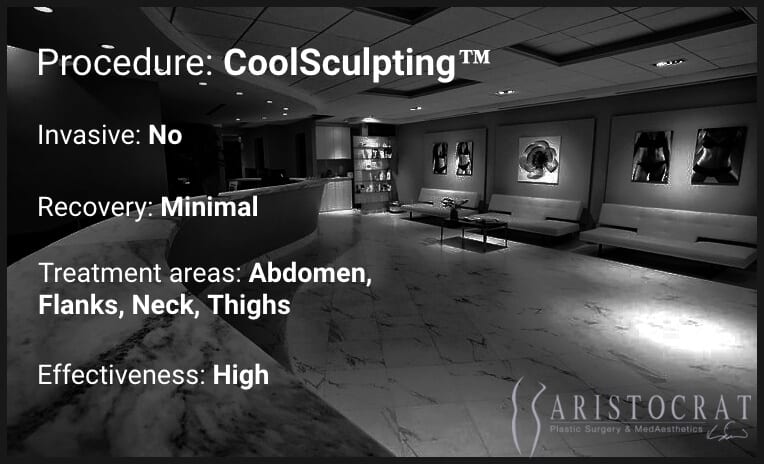
There are a lot of reasons why a non-invasive treatment would be preferred:
- No recovery time. Not every one of us can afford to take time off work or other responsibilities. Not all of us want to. Due to their non-invasive nature, many liposuction alternatives require minimum to no recovery period.
- No scars. During liposuction, small incisions are made into your body. The scars that they leave are minuscule and really easy to hide. Nevertheless, some patients prefer to walk out of the surgeon’s office without any ‘evidence’ on their body.
- No risk of side effects or complications. At Aristocrat Plastic Surgery, you’re in good hands. However, not all surgeons will go the extra mile to figure out how to keep you safe. If you’re unsure about your doctor’s qualifications, best to stick to non-invasive methods.
- No surgery. Some liposuction candidates may have preexisting health conditions that may make the surgery a sub-optimal choice, if not an impossible one. Non-invasive methods are a good option in those cases.
Does CoolSculpting Work?
At this point in time, it is safe to say that CoolSculpting—a non-invasive technology developed by ZELTIQ—is one of the best alternatives to liposuction.
The CoolSculpting device works in a simple, yet effective manner:
-
-
- The device is placed on your skin towards the problematic fat pocket
- It creates suction that attracts the fat cells underneath our skin towards the cold head of the device
- Said fat cells are then frozen and die, after which they leave your body organically for good.
-
The technology is proven, and it does work. It has been proven both scientifically and practically:
-
-
- In this study, Eric F. Bernstein, MD, MSE found that CoolSculpting results last for at least 6-9 years after a long-term follow-up with the patients
- Over 7,000,000 CoolSculpting procedures to date have been performed worldwide with high patient satisfaction
- 86% of patients showed visible improvement after CoolSculpting, while 82% of patients would recommend the procedure to their friends and family
-
However, there are a few key differences between how liposuction and CoolSculpting work:
-
-
- Liposuction provides immediate, dramatic results, while CoolSculpting will require multiple sessions to produce significant results on average
- Liposuction is more effective overall. In rare cases, where the fat levels are low and the fat distribution is even and favorable, CoolSculpting may produce similar results to liposuction. But, again, those cases are rare. If you want the sure thing, go for lipo.
-
With that information in mind, some people will find CoolSculpting a better option. Those people likely:
-
-
- Have small, evenly distributed fat deposits
- Are keen to avoid surgery for medical or personal reasons
- Cannot afford or do not wish a recovery period
- Do not want to take any chances with scars, side effects and complications
- Are yet to have their first plastic surgery procedure
-
Likewise, patients who will stick to liposuction will:
-
-
- Have bigger, problematic fat deposits that don’t respond to diet or exercise
- Want a more dramatic change
- Are okay with more aggressive surgical treatment
- Are okay with small, easy-to-hide scars
- Can afford to take time off after the procedure
-
What Does It Feel Like to Have CoolSculpting?
During the procedure, no anaesthesia is required. Most people do not feel any pain during CoolSculpting.
Except for occasional tingling sensations and temperature changes (hot-cold), CoolSculpting really feels not much more uncomfortable than getting your hair done.
Here you can take a closer look at the initial CoolSculpting consultation:
After the procedure, you may experience some swelling and tenderness on the skin in the treated area. This should fade away in a matter of weeks, sometimes, even days.
Minimally Invasive Options: Liposuction vs. Cellfina, Laser-lipo, SmartLipo and Other Alternatives
While CoolSculpting is definitely the most popular—and, arguably, effective—one, there are many similar non-invasive alternatives available on the market for people looking to address pronounced fat deposits.
Each of them works a little bit differently, and some are more effective on particular body parts than others.
But one thing they do have in common: none of them require a surgical incision.
As a general rule, all non-invasive lipo alternatives are:
-
-
- Less effective than liposuction (in most cases)
- Chosen by patients who cannot or do not want to undergo the knife
- Chosen by patients who do not want a recovery down-period
-
So, if that’s your cup of tea, then you should definitely research all the options available. Each of them is most effective in their particular domains.
Liposuction vs. Cellfina, the “Cellulite Killer”
Marketed as the ultimate “cellulite” treatment, this FDA-approved technology lives up to its name.
First of all, let’s discuss how Cellfina is different from liposuction.
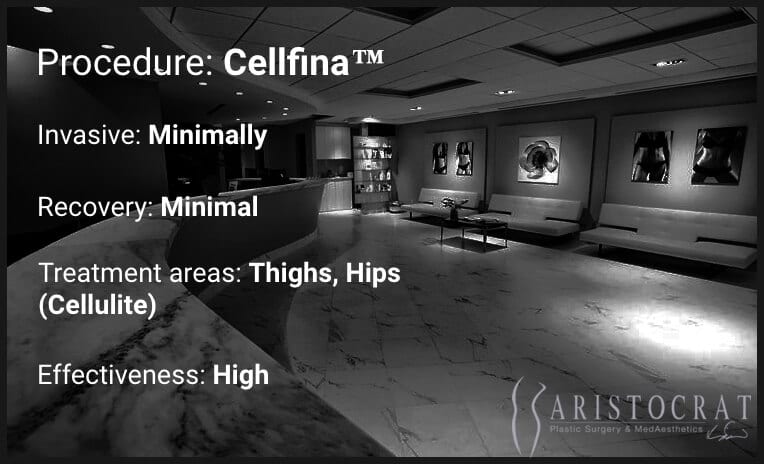
The big reason why liposuction has stood the test of time is because it can remove fat from the very core of localized fat pockets. The liposuction needle can reach right to the center of the problem.
Cellfina doesn’t do that.
The device has a small needle that goes just beneath the surface of your skin, without leaving any scars.
That’s where the surface fat is. When it distributes unevenly, it clumps into small “waves”, stretching the skin, creating the appearance we call “cellulite.”
When the surface fat is removed, the skin looks much more even.
However, the big question is:
Does Cellfina Work Long-term?
It does.
According to a 2017 study by Dr. Daniel P. Friedman and others:
-
-
- Practitioners reported significant improvement after a single session that lasted for at least 40 months
- 92.7% patients showed significant improvement after 3 months, while 94% showed significant improvement after 1 year
- 94% of patients said they were satisfied with the results 1 year after the procedure
-
What Does Cellfina Feel Like?
On the scale of 1-10, patients reported 4.5 on average in terms of pain felt during the procedure.
After the procedure, many reported “mild” aching for up to 6 months in the treated area.
To sum up:
-
-
- Liposuction targets the core of fat deposits, while Cellfina reduces surface level fat
- Liposuction is best to deal with unruly fat bulges (“love handles”, “double chin”), while Cellfina deals with cellulite-like appearance on hips and legs
- Both procedures are effective long-term in their respective domains
-
Liposuction vs. Laser-lipo (SmartLipo) and Cellulaze, the “Fat Melter”
Another big group of non-invasive liposuction alternatives are so-called laser-lipo—or SmartLipo—devices.
These involve Zerona, SmartLipo MPX and other well-received technologies.
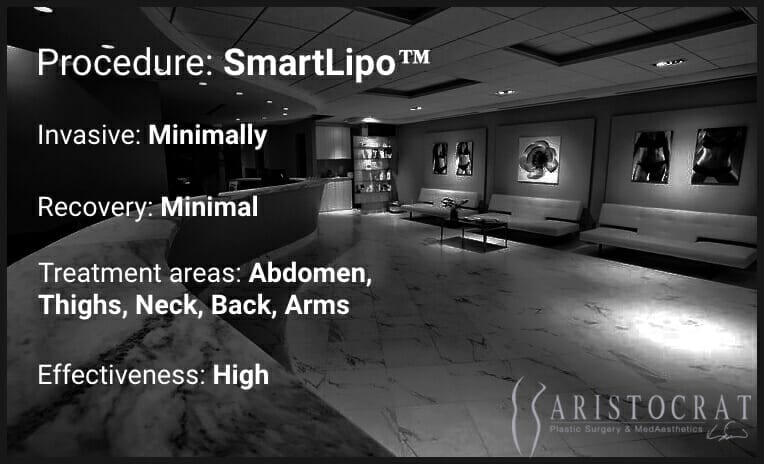
The biggest differences between traditional liposuction and laser-enhanced liposuction are:
-
-
- SmartLipo requires only very small incisions
- During traditional liposuction, the fat is extracted via physical manipulation, whereas laser-lipo liquifies the fat for easier extraction
- SmartLipo has a slightly shorter recovery time and less bruising
-
However, using laser devices in liposuction is quite common, thus SmartLipo is not considered a separate procedure, but rather a situational sub-discipline of traditional liposuction.
We also offer a slightly upgraded technique called Cellulaze when doing laser liposuction. It functions on the basis of SmartLipo laser technology, with a few added benefits, the biggest of which is tightening the skin around the incision site.
As the appearance of cellulite highly revolves around skin elasticity, Cellulaze is an extremely effective technology to use during laser liposuction.
As laser-assisted lipoplasty shares many core mechanics with traditional liposuction, it would be counter-productive to compare them as alternatives.
Instead, your board-certified surgeon will evaluate your goals and expectations, and will suggest an action plan that may or may not involve using laser devices.
A Warning About Other DIY Liposuction Alternatives
Zerona this, Cellfina that…
There are a lot of companies producing all sorts of devices and technologies, claiming to have found the “ultimate non-invasive cure” to all of your fat problems.
Some of these solutions are not FDA-approved. Some of them don’t need any sort of license or credentials to purchase.
Beware. Even if they flash the FDA badge, you do not want to put your health at risk. Plus, many of these “alternatives” don’t even work.
Final Verdict: Stick to Liposuction, Unless You Have a Good Reason Not To
The medical tech sector truly has come a far way in researching various liposuction alternatives.
We are very happy to see minimally invasive and non-invasive options appear in the market that leave patients satisfied and produce safe, lasting results.
10-20 years from now, these alternatives might even replace traditional liposuction altogether.
However, to this date, there is no procedure that can attack localized fat pockets with the same effectiveness, quickness and safety as liposuction. It’s just the way it is.
Since we always want our patients to achieve their desired looks, our general recommendation would be to always consider liposuction first.
However, should you have any doubts about your surgeon’s qualifications or level of commitment, please explore other options as well. Liposuction can be dramatically effective, but it can also cause a lot of harm when performed by the wrong surgeon.
Dr. Tehrani has completed countless liposuction procedures, with hundreds of satisfied patients ready to vouch for his qualifications. Give us a call or visit us at one of our offices in New York and Long Island, and we’ll guide you through your transformational journey.
